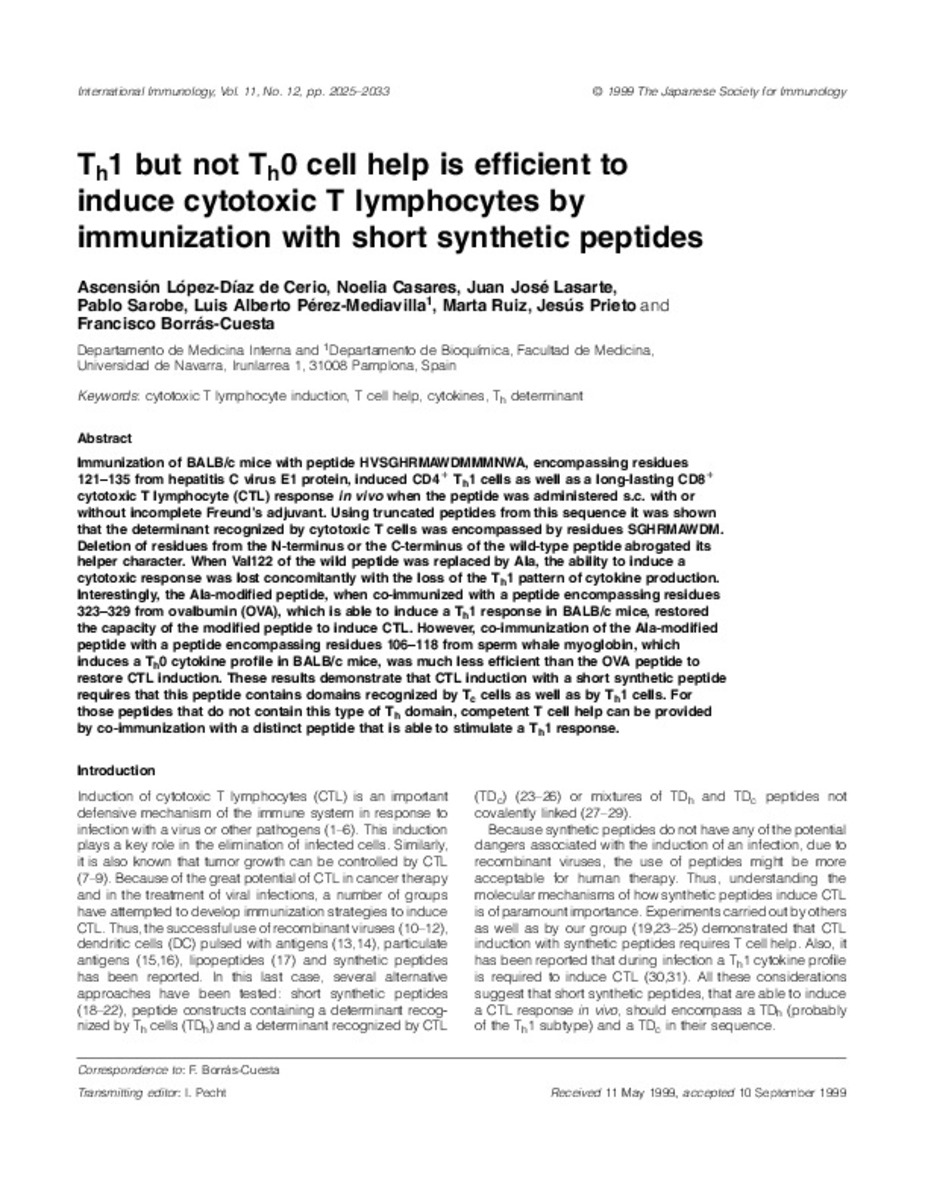Full metadata record
| DC Field | Value | Language |
|---|---|---|
| dc.creator | Lopez-Diaz-de-Cerio, A. (Ascensión) | - |
| dc.creator | Casares, N. (Noelia) | - |
| dc.creator | Lasarte, J.J. (Juan José) | - |
| dc.creator | Sarobe, P. (Pablo) | - |
| dc.creator | Perez-Mediavilla, L.A. (Luis Alberto) | - |
| dc.creator | Ruiz, M. (Marta) | - |
| dc.creator | Prieto, J. (Jesús) | - |
| dc.creator | Borras-Cuesta, F. (Francisco) | - |
| dc.date.accessioned | 2012-04-13T15:18:07Z | - |
| dc.date.available | 2012-04-13T15:18:07Z | - |
| dc.date.issued | 1999 | - |
| dc.identifier.citation | Lopez-Diaz de Cerio AL, Casares N, Lasarte JJ, Sarobe P, Perez-Mediavilla LA, Ruiz M, et al. T(h)1 but not T(h)0 cell help is efficient to induce cytotoxic T lymphocytes by immunization with short synthetic peptides. Int Immunol 1999 Dec;11(12):2025-2034. | es_ES |
| dc.identifier.issn | 1460-2377 | - |
| dc.identifier.uri | https://hdl.handle.net/10171/21650 | - |
| dc.description.abstract | Immunization of BALB/c mice with peptide HVSGHRMAWDMMMNWA, encompassing residues 121-135 from hepatitis C virus E1 protein, induced CD4(+) T(h)1 cells as well as a long-lasting CD8(+) cytotoxic T lymphocyte (CTL) response in vivo when the peptide was administered s.c. with or without incomplete Freund's adjuvant. Using truncated peptides from this sequence it was shown that the determinant recognized by cytotoxic T cells was encompassed by residues SGHRMAWDM. Deletion of residues from the N-terminus or the C-terminus of the wild-type peptide abrogated its helper character. When Val122 of the wild peptide was replaced by Ala, the ability to induce a cytotoxic response was lost concomitantly with the loss of the T(h)1 pattern of cytokine production. Interestingly, the Ala-modified peptide, when co-immunized with a peptide encompassing residues 323-329 from ovalbumin (OVA), which is able to induce a T(h)1 response in BALB/c mice, restored the capacity of the modified peptide to induce CTL. However, co-immunization of the Ala-modified peptide with a peptide encompassing residues 106-118 from sperm whale myoglobin, which induces a T(h)0 cytokine profile in BALB/c mice, was much less efficient than the OVA peptide to restore CTL induction. These results demonstrate that CTL induction with a short synthetic peptide requires that this peptide contains domains recognized by T(c) cells as well as by T(h)1 cells. For those peptides that do not contain this type of T(h) domain, competent T cell help can be provided by co-immunization with a distinct peptide that is able to stimulate a T(h)1 response. | es_ES |
| dc.language.iso | eng | es_ES |
| dc.publisher | Oxford University Press | es_ES |
| dc.rights | info:eu-repo/semantics/openAccess | es_ES |
| dc.subject | Cytotoxic T lymphocyte induction | es_ES |
| dc.subject | T cell help | es_ES |
| dc.subject | Cytokines | es_ES |
| dc.subject | Th determinant | es_ES |
| dc.title | T(h)1 but not T(h)0 cell help is efficient to induce cytotoxic T lymphocytes by immunization with short synthetic peptides | es_ES |
| dc.type | info:eu-repo/semantics/article | es_ES |
| dc.relation.publisherversion | http://intimm.oxfordjournals.org/content/11/12/2025 | es_ES |
| dc.type.driver | info:eu-repo/semantics/article | es_ES |
Files in This Item:
Statistics and impact
Items in Dadun are protected by copyright, with all rights reserved, unless otherwise indicated.






